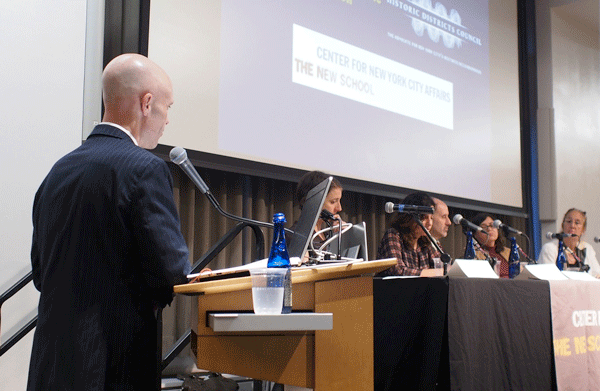
BY ALBERT AMATEAU | A panel of community activists and local politicians considered affordable housing and historic preservation as related issues at a forum the drew about 200 Village residents last week.
The event — held at the New School, and sponsored by the Greenwich Village Society for Historic Preservation and the Historic Districts Council — was partly a response to the Real Estate Board of New York’s frequent assertions that the expansion of historic districts is partly to blame for the lack of affordable housing.
“Affordability and preservation are not in conflict,” declared Andrew Berman, G.V.S.H.P. executive director and the moderator of the Sept. 16 roundtable discussion.
Indeed, historic districts and Landmarks Preservation Commission designation often protect existing affordable housing, Berman said. Residents of two prominent affordable residential projects in the Village — the high-rise 505 LaGuardia Place and the West Village Houses between Bank and Morton Sts. — pushed hard for landmark designation, Berman recalled.
Panel members included East Village City Councilmember Rosie Mendez; Manhattan Borough President Gale Brewer; Harvey Epstein, community development project director at the Urban Justice Center; Nadine Maleh, a developer of supportive housing at the nonprofit Community Solutions; and Rachel Meltzer, assistant professor of urban policy at the New School. The panel focused mainly on the lack of affordable housing, on the threats to existing rent-stabilized apartments and on opportunities to create new affordable units.
“The weakening of rent regulations, vacancy decontrol and decontrol of high-rent apartments [more than $2,500 per month] has taken countless apartments out of the price range of most people, especially in Manhattan,” Mendez said.
“More than 100,000 apartments have lost rent regulation in recent years,” Brewer said, noting the increasing number of Mitchell-Lama landlords taking the option of buying out of the state program that moderated rents and capped sale prices.
“There have been 20 years of government failure to support affordable housing,” Epstein said. “Now, even H.D.F.C.s [Housing Development Fund Corporations] can be sold for $1 million,” he added. H.D.F.C.’s are financed low-cost limited-equity property. Epstein suggested that penalties should be imposed on landlords who elect to leave public affordability programs.
Because there are fewer and fewer available sites for housing, nonprofit developers must bid against luxury developers, Maleh noted. She added that despite the loss of government funding, there are still opportunities.
While government funding for housing has nearly evaporated and is gone for the foreseeable future, affordable housing can still be financed by merging private and public funds, Meltzer said. And government has the power to mandate affordable housing for those partnerships, she added.
“We already gave 421A tax abatements to luxury housing developers in some parts of Manhattan,” Mendez observed, referring to a city program that was especially active a decade or so ago.
Maleh noted that federal tax credits are available for redevelopers of properties on the National Register of Historic Places. Her nonprofit development group has developed supportive housing in preservation areas including Times Square; the Prince George, on E. 28th St.; The Christopher, on W. 24th St. (the former McBurney YMCA residential wing; and The Andrews, built in 1901, on Bowery at Spring St.
In recent years, the voluntary 80/20 program (80 percent market rate and 20 percent stabilized rent) has been available for developers who receive a tax break — with the affordability part of such projects usually lasting 20 years. Epstein said the affordability percentage could be increased to 40 or 50 percent. Even more desirable, he said, would be to mandate contextual zoning throughout the city with permanent rent restrictions.
The goal is to encourage construction or redevelopment of new housing in scale with the neighborhood, he explained. Epstein suggested that any developer of a project with an F.A.R. (floor-area ratio) of 4 or more should be required to create affordable housing.
“It’s a tradeoff between density and affordability,” Meltzer said. “Affordability does require density.”
What must not continue is the recent practice of using parking lots and green spaces in New York City Housing Authority developments to construct “infill” housing — high-rise, mostly market-rate buildings, Epstein said.
A potential for affordable apartments lies in the “hundreds of vacant, warehoused apartments” in existing buildings, Brewer said. “We have to plan and figure out how to realize that potential,” she said.
“Government has abdicated its responsibility to enforce its regulations,” said Epstein. The city policy in recent years has been to allow developers and landlords to “self-certify” their compliance with building regulations and housing rules, with only sporadic checking by city agencies, he noted.
The lack of government investment in affordable housing is due to a lack of will, Epstein charged.
“We spent public money to build a stadium in the Atlantic Yards in Brooklyn,” he said. “In Queens, we spent public money to build a mall. The question is, what are we investing in?”

















